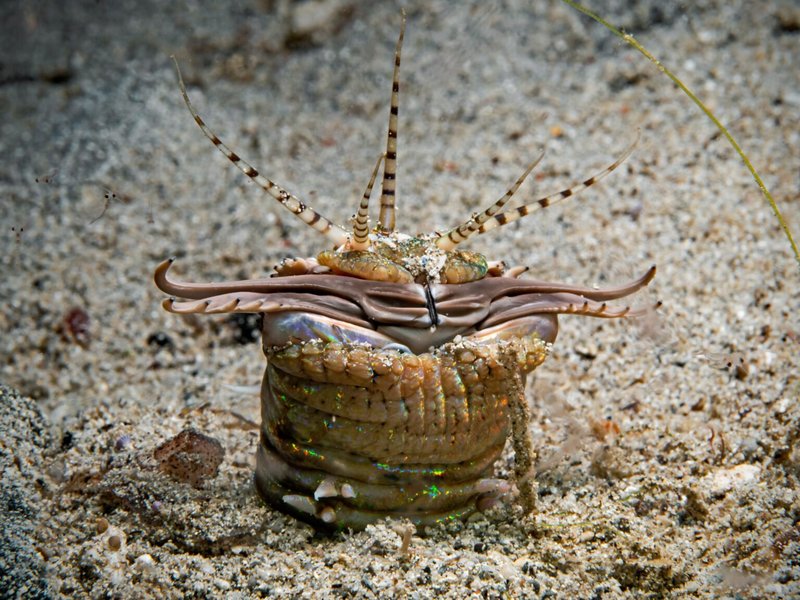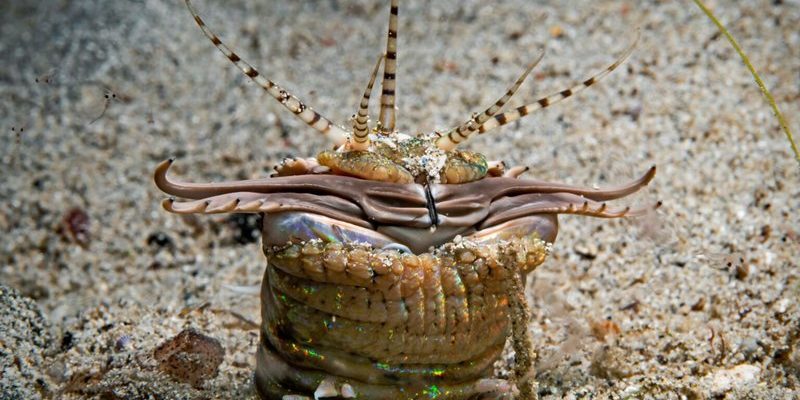
Imagine being a Bobbit worm. You’re snug in your burrow, with only your head peeking out, waiting for unsuspecting prey to swim by. You have incredible sensory capabilities that help you detect everything from vibrations to chemical signals in the water. It’s almost like having superpowers that allow you to “see” and “feel” your environment in ways we can only dream of. So, let’s dive deeper into what makes these worms so special in terms of their intelligence and sensory perception.
What Is a Bobbit Worm?
The Bobbit worm, scientifically known as *Eunice aphroditois*, is a marine creature found in tropical and subtropical waters. These worms can grow to impressive lengths—sometimes reaching up to 10 feet! They are renowned for their striking appearance, which includes a segmented body covered in bristles, giving them a somewhat majestic yet intimidating look.
But what really sets them apart isn’t just their size or looks; it’s their unique lifestyle. They spend most of their time hidden in burrows on the ocean floor, using their keen senses to detect passing prey. When dinner swims too close, they strike with incredible speed and agility. It’s almost like a game of hide-and-seek, but instead of children, it’s a cunning predator and its unsuspecting meal.
Understanding Their Intelligence
When we talk about intelligence in animals, it generally refers to problem-solving, learning, and adaptability. Bobbit worms showcase a different kind of intelligence, one that’s closely tied to their survival in the harsh underwater environment. Their ability to remain hidden while efficiently catching prey is a testament to their instinctual knowledge rather than learned behavior.
Think about it: Bobbit worms don’t have a brain like we do, but they possess a nervous system that helps them react to their environment. They can sense vibrations and chemical changes in the water, which allows them to react swiftly and effectively. This form of intelligence, while not like ours, is perfectly adapted to their needs. Here’s the thing—sometimes, survival intelligence is about mastering your environment, and the Bobbit worm does it well.
Bobbit Worm Sensory Perception
Bobbit worms are equipped with impressive sensory tools that allow them to interact with their environment in specialized ways. Their sensory perception revolves around two main aspects: chemical detection and vibration sensing.
1. Chemical Detection: These worms can pick up on subtle changes in chemical concentrations in the water. This ability helps them identify the presence of prey from a distance. It’s like having a built-in radar that alerts them when a potential meal swims by. Imagine tasting the air around you to find out what’s happening nearby—that’s how Bobbit worms navigate their world.
2. Vibration Sensing: They have specialized cells that detect vibrations in the water, which is crucial for catching prey. When fish or other small creatures swim nearby, the vibrations alert the worm, allowing it to prepare for a quick strike. It’s almost like (you guessed it!) a sixth sense that ensures they never miss a meal.
Hunting Strategies
The Bobbit worm’s hunting strategy is as fascinating as its sensory capabilities. They are ambush predators, relying heavily on their environment for successful hunts. Here’s how they do it:
– Burrowing: Bobbit worms spend much of their time buried in the sand, with only their heads visible. This camouflage makes them almost invisible to passing prey. It’s a waiting game, but they have the patience of a predator.
– Quick Strikes: When prey comes within reach, they strike swiftly—like a snake snapping out its tongue. Their strong jaws can grab onto fish and other small creatures, pulling them into their burrow for consumption. This combination of stealth and speed is what makes Bobbit worms effective hunters.
– Adaptability: If one hunting method doesn’t work, they can easily adjust. Whether it’s changing the position of their burrow or altering their feeding habits, these worms are incredibly adaptable to their environment.
Communication among Bobbit Worms
While it’s easy to think of intelligence as something that involves complex communication, Bobbit worms communicate differently. They don’t talk or exhibit social behaviors like some animals do, but they use chemical signals to communicate with each other, especially during mating.
Their communication involves releasing specific pheromones into the water. This can indicate various things, such as readiness to mate or marking territory. It’s a silent language, one that’s only understood by their own species. Imagine sending a text message without needing a phone—that’s kind of what these worms do with their chemicals.
Bobbit Worms in the Ecosystem
Bobbit worms play a crucial role in their marine ecosystems. They contribute to the biodiversity of the environment, acting as both predators and prey in the food web. Here’s why they matter:
– Predatory Role: As predators, they help control the population of smaller fish and crustaceans. This balance maintains the health of the ecosystem, preventing any one species from overwhelming others.
– Nutrient Recycling: When Bobbit worms consume prey, they help recycle nutrients back into the ocean. Their waste becomes food for other organisms, contributing to the overall health of marine habitats.
– Habitat Formation: Their burrowing habits can create habitats for other marine life. The structures they form in the ocean floor can provide shelter for various organisms, showcasing their impact beyond just being a predator.
Conservation of Bobbit Worms
Despite their fascinating qualities, Bobbit worms face challenges in their natural habitats, primarily due to human activities. Overfishing, habitat destruction, and pollution can threaten their populations. Conservation efforts are essential for maintaining their presence in the ocean.
Supporting marine conservation initiatives can make a difference. This includes reducing pollution, protecting marine habitats, and advocating for sustainable fishing practices. Every little bit counts, and even small actions can help preserve these incredible creatures and the ecosystems they inhabit.
Bobbit worms might seem like simple creatures at first glance, but their intelligence and sensory perception offer a rich tapestry of complexity and adaptation. They remind us that intelligence comes in many forms, each uniquely suited to its environment and lifestyle. So next time you think about the wonders of the ocean, remember the Bobbit worm and its silent, swift world beneath the waves.

